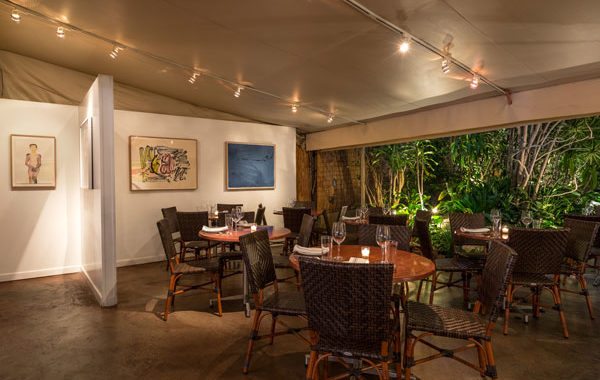Known as a pioneer of the farm-to-table dining movement, Michael McCarty founded his first restaurant, Michael’s, in Santa Monica in 1979. Ten years later he would open his second location in Midtown Manhattan. Michael and his wife, the artist Kim McCarty, would become known as true friends and patrons of artists—collecting, providing alternative exhibition space in their restaurants and often even trading food for art. A real—some would even say storied—artistic community continues on with their son Chas McCarty, who became the General Manager of Michael’s Santa Monica in 2016. From Ed Ruscha to Analia Saban, the McCartys know good art.
How did you start collecting and when was the decision made to bring part of your collection into your restaurants?
Michael: In the mid- to late ’70s, Kim was enrolled in the ArtCenter College of Design and I was conceptualizing and planning for what would become Michael’s Santa Monica. Art and restaurants were our day-to-day routine, so naturally the two melded together. The design of the restaurant mirrored that of our home in that both emulated art galleries.
While all of that was happening, we were attending art events and that’s ultimately how we met Peter Goulds from L.A. Louver. At the time, there were only a handful of galleries in Los Angeles and Peter’s was one to visit. We wanted to collect art, and to have it at the restaurant, so when we met, we expressed as much to Peter and he said “Let’s have lunch!” And it all went from there. Peter was instrumental in introducing us to people—guests, artists, friends—and in helping us build our “ground-zero collection.”

Photos by Jakob Layman.
Couldn’t have had better advice from the sounds of it. Tell me about how the restaurant went from trading work for meals to curated exhibitions?
Michael: Elyse and Stanley Grinstein (founders of Gemini G.E.L Press) lived 10 minutes away from the restaurant and would bring in many New York artists like Helen Frankenthaler, Jasper Johns, Robert Rauschenberg and Claes Oldenburg. These artists were flying in to Los Angeles to print at Gemini G.E.L, and while they were in town they would stay at Stanley and Elyse’s house and come to Michael’s for dinner.
Kim: “After I got my MFA graduate degree at UCLA, we started doing shows upstairs—it all started with a show we did with my graduating class in the late ’80s. It grew from there when even major artists like Ed [Ruscha] and Joe [Goode] expressed interest in showing their less commercial work in an intimate setting and not in a gallery. The artist Analia Saban was instrumental in co-curating many shows with me and introducing me to many of her peers.

Photos by Jakob Layman.
This year Chas and Christopher Schwartz have taken the lead in curating shows upstairs, now aptly and formally named ´The Gallery.´ When did the switch occur and why? How do you see the artistic relevance of the space today?
Michael: “We stopped doing the shows around 2012—we really needed to focus on our menu revamp at the time and a larger renovation. And then when we started with Chef Miles Thompson in 2016 (a James Beard 2018 finalist), we spent some more time throwing ourselves into the next chapter. Along with the menu change on both the culinary and beverage side, we did a slight interior fresh—new paint on the walls, we swapped out some of the collection and rearranged the art on both levels. The launch of ‘The Gallery’ earlier this year has been exciting for us because it really brings it full circle for us. Our son Chas, who has many friends who are emerging artists, jump-started these shows back up with Christopher [Schwartz] and it’s fantastic seeing the next generation doing what we loved in the first place almost 40 years ago.”
Chas: In terms of relevance, I think food is finally being understood as something cerebral and communicative as visual art is, but the biggest draw for me is the possible introduction of comfort into naturally uncomfortable places—and I think art openings are incredibly uncomfortable. The lighting is often awful, the acoustics are loud, and it is more of a social game than a true viewing process. I like the idea of drinking a lot of wine and looking up from the conversation you’re locked into to see a Cy Twombly disguised into a well-lit wall. The memory becomes visceral. You can think of it like the first time you heard a rock ‘n’ roll song on the radio.”
One of your favorite memories with an artist in the collection?
Kim: Judy Chicago is in our men’s bathroom upstairs in Santa Monica—she would always complain after she came out of the bathrooms in Michael’s New York because they mostly featured 1962 Dennis Hopper photos of male artists and actors. So one day she brought us a photo of herself in the nude with the inscription ‘For Michael, a female presence in the men’s bathroom.’”


